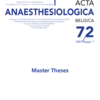Effect of intravenous clonidine on postoperative agitation and
recovery time after tonsillectomy
Clonidine; emergence delirium; tonsillectomy; anesthesia; recovery room
Published online: Apr 21 2022
Abstract
Tonsillectomy is routinely performed in most hospitals, both in adult and pediatric patients. A main objective of anesthesia care for these procedures is swift and comfortable recovery, permitting rapid discharge from the Post Anesthesia Care Unit (PACU). In preventing agitation, overall experience as well as rebleeding risk and the length of stay (LOS) in the PACU stand to improve. Clonidine is known for having an anxiolytic, sedative and analgesic effect, as well as for reducing postoperative vomiting in children. At our department, anesthesia consists of propofol/sufentanil/ sevoflurane anesthesia, and paracetamol/diclofenac analgesia. Some anesthetists routinely give additional clonidine 1 mcg·kg −1 to children for tonsillectomy, others never do. This retrospective study evaluates the effect of intravenous clonidine on agitation and recovery time following tonsillectomy in different age groups. Out of all consecutive tonsillectomy cases between 1/2016 and 11/2018, a convenience sample of 473 patients was selected and included in this retrospective analysis. Of 473 included patients, 383 did not receive clonidine perioperatively and 90 did. Agitation was defined as a Ramsay Sedation Scale score of 1. In pediatric patients (<18 years), clonidine produced a relative risk reduction of agitation of 35.7% (p=0.235). We found a reduction in LOS in both pediatric and adult patients, of 5 and 11 minutes respectively (p=0.242 and p=0.262). Clonidine seems to reduce agitation and LOS in the PACU when administered perioperatively in patients undergoing tonsillectomy. A sample size calculation shows 463 patients are required in each group to achieve power of 95%. Because of the retrospective nature of our study, with its inherent risk of confounding factors, our findings should be confirmed in prospective studies.
